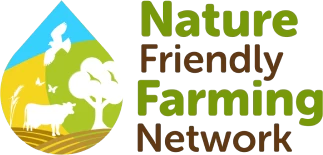Calving happens indoors, then lambing outside on the higher ground alongside the marsh. At this time of year the silver seas from the winter reduce, revealing not just our summer grazing but exposing bare mud and waking fens. A changing of the guard also occurs, the flocks becoming pairs, the thrushes replaced by the warblers, and their breeding season follows that of the cattle and sheep. A stolen moment in the dawn at lambing can reveal calling lapwing above the morning mist, frolicking in the air and peewitting in the sunshine they steal before it gets to the ground. Their assertion of land ownership is joyously perceived by us shepherds, waist-high in dissolving fog. How we love those moments.
The summer brings grass, the waters confined to the ditches and patterned pools created over a lifetime. However, the subtly intricate weaving of life into the farmscape continues, rampant beetles whirligigging on crystal-clear water surfaces pocked with a multitude of emerging flowers. Frogbit, arrowhead and water violet vie with thuggish reeds and reedmace. Dragonflies cause us to boast about having so many species that we are internationally important. The place “teems with quiet fun”. Whoever coined the term “dull as ditchwater” must have been blind and deaf.
As summer ends, our southern location brings the gathering of swallows, skimming insects disturbed by cattle hooves and the moving of the flock. Starlings pick through fresh dung alongside yellow wagtails. We have learnt to cherish this intimacy through driving down the use of insecticidal medicines in our organic regime. And there is a lawlessness without water, as drying ditches, wet fencing most of the year, or upside-down hedges, lose their ability to contain the animals. An autumn spreading that precedes the rains and the start of the cycle.
Running a business predicated upon the naturalness of a fully functional wetland has been dependent on other relationships. Support from Natural England and the water level management Board, for example, our vet and many local naturalists. Most importantly, our family. There are many voices to listen to, much to consider and balance. Should green-winged orchids trump silage yields, or lapwing meadows be replaced by expanding reedbeds?
The farm talks to us, sometimes loudly but often musically. It begins to change us and inform us. The water is what we are made of too, and over a lifetime, the resonance is satisfaction.
Jon Thornes - South Ormsby Estate, Lincolnshire, England
How the soil endured the drought
This year, the rain didn’t come, not as much as normal.
Not in spring, when it was expected. Not in early summer, when the young plants reached up, waiting. The sky stayed pale and tight-lipped. And deep beneath the surface, the soil began to feel it.
At first, the soil did what it always did: held on. It clutched every drop from the last rainfall, shared it carefully with the roots still reaching downward. The networks of fungi whispered to one another, stretching their filaments in quiet cooperation, distributing what little moisture remained.
But as the days passed and the sun grew fierce, the cracks and dryness began to show, not out of anger or failure, but out of honesty. This was not a sign of giving up. It was the soil’s way of saying: “This is real.”
The beetles and worms burrowed deeper. Seeds that might have sprouted decided to wait. Life did not vanish; it simply changed rhythm.
The soil remembered other years like this. Drought was not new, only our forgetfulness was. Long before forecasts and fertilisers, the land had learned to adapt, to slow, to survive. And now, it was asking the same of us.



